The Standing Ram Golden Fleece & Charles V
1500–1558
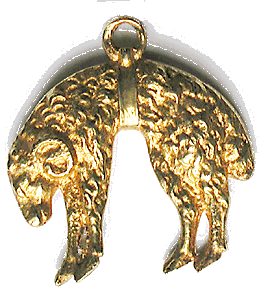

On our opening page of this article we introduced the standing ram fleece as a noteworthy historical art form. There we showed the few surviving examples known to us. Here we look into the art of the period to trace the history of the standing ram.
The standing ram style Golden Fleece, as seen above, is first seen in the Low Countries in the late 15th century in portraits of Philip the Fair and some other members of the Golden Fleece. Even from the earliest days of the order the standing ram type of fleece was seen in various portraits, although we can not be certain that the depictions are contemporary or from life. In the original illuminated manuscript of the Chroniques du Hainault there is a miniature by Van der Weyden showing the young Charles the Bold wearing a very standing ram-like fleece. Below, from the left, is a collar of Philip the Good, a fleece hanging from a gold chain on Charles the Bold from a later engraving, and a collar of Philip the Fair from a painting by the Dutch School; and to its right another, very similar, painting of Philip the Fair by the Master of the Legend of Mary Magdalene with a standing ram fleece that is located in the Rijksmuseum and dating to c. 1500.
Of immediate interest in the development of the standing ram fleece is the famous family portrait by Bernhard Strigel, an artist much favored by Emperor Maximillian. Although a later assemblage from c. 1512, when both Mary of Burgundy and Philip the Fair were dead, it is likely from life for the three grandsons. Both Maximillian and Charles V, seen below, show clear standing ram fleeces very similar to the Aldenhaag one. Being so favored by the Emperor, Strigel was most likely given access to family artifacts and art to make his assemblage, and his impeccable eye for detail suggests trusting his depictions as accurate. Philip the Fair has a collar in the picture, but the fleece is hidden behind his mother, and Ferdinand has a gold chain that likely held a fleece, also obscured by Maximillian’s hand. The third portrait is from the Prayer Book of Juanna la Loca, wife of Philip the Fair, from a miniature showing the pair of them enthroned c. 1500. Although somewhat rough the fleece is clearly of the standing ram type, the first example of it known in Spain. Last is a standing ram worn by Philip the Fair in a portrait in the Louvre that could be the same as the one painted in the Prayer Book.
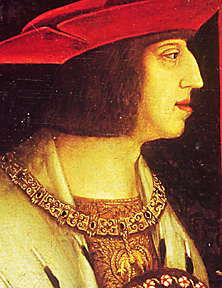
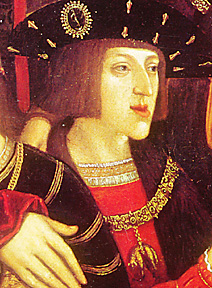
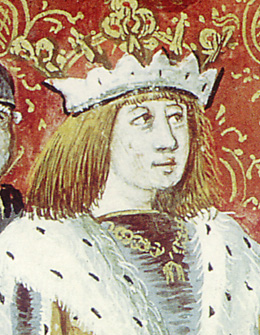
Some other early examples are, from the left, Philip the Fair by John of Flanders, an early collar fleece in the Schatzkammer from the early days of the order, a Hans Maleer painting of Charles V’s brother Ferdinand I and a Hans Krell painting of Louis II of Hungary (before 1526). John of Flanders was court painter to Isabella, and after her death in 1504 turned to religious paintings, so this portrait is before 1504. The Philip portrait shows elements of both the standing ram style and a peculiar Habsburg style of a very elongated fleece known in the Renaissance and then in only one later, likely 18th century, bijou. seen on the insignia page of the Confrérie Amicale and a couple of modern reproduction castings of it. Note also the similar elongated shape in the Philip the Fair collar fleece above.
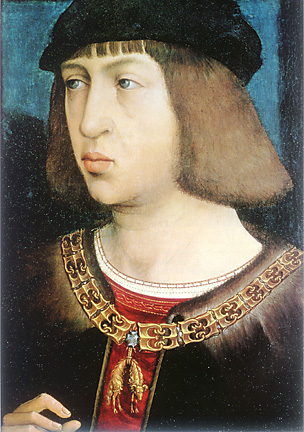
The use of the standing ram fleece is not confined to the Imperial family and is seen on many Golden Fleece members of the first half of the 16th century. Below are some members of the Golden Fleece of this period wearing versions of the standing ram type. From the left is an engraving of Christian II of Denmark (member in 1519), Henry VIII (member in 1505) and a Cranach painting of George, Duke of Saxony (member 173 in 1531). Numerous other examples are shown in the small portraits of knights reproduced in the La Insignie Orden del Toíson De Oro book, and a list of the member numbers showing this style fleece will be found through our Catalog Reference Page, and many more examples.on the various documentation pages.
Charles V was raised in the Netherlands, and due to his tender years was permitted some exception from the rules, such as not having to wear the heavy collar at all times. This openness to change and the good sense of Charles V led to relaxed wearing requirements for all members of the order, and the fleece alone on a red ribbon became the new daily standard display. This permits us to see the fleece being worn in a less formal setting than when collars are worn, and these are likely more true to life.
If we examine surviving portraits of Charles V, taking into account the known inaccuracy in detail by painters who may never have seen him, we constantly encounter the standing ram type in later portraits as well. Below are fleeces in early portraits worn by Charles V. From the left: one by Bernhard van Orley c. 1516 of the young Charles V, a second around 1530-1535, the third c. 1514-16 by a Flemish School artist and below the 1522 bust. In the van Orley portrait the standing ram form is seen although the body is not full thickness, in the second and third it is much more clearly this style, and in the bust it is clearly a fully developed standing ram.
As time passed the standing ram fleece is still seen associated with Charles V throughout his life. Seen below, from the left, is a standing ram fleece on an Augsburg parade helmet from 1520, the painted arms of a knight of the order from the 1519 Chapter at Barcelona (all 51 arms depicted there have the same style fleece), and a famous Titian painting of Charles V at the 1547 battle of Mühlberg with a standing ram on a red ribbon. There are dozens of other example in contemporary art.
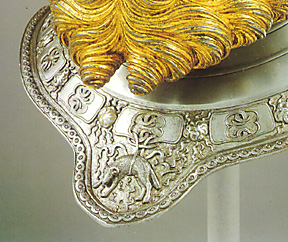
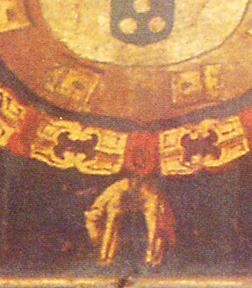

We also see the standing ram in sculptures of Charles V. On the left is a marble statue of Charles V in the Prado, then a bronze by León Leoni in 1553.
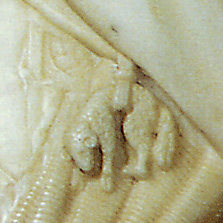
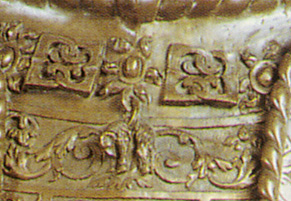
Not only the standing ram fleece, but the Golden Fleece itself, were virtually unknown in Spain before Philip the Fair arrived around 1500. Within a few years the form had found its way into architectural ornament, which was a very conservative craft then. In the Middle Ages and early Renaissance, artists and craftsmen did not work from life and sketches but from model books with stylized forms that were in the fashion of their times. Soon after Charles V arrived in Spain in 1519 we see this very Low Country fleece on official construction projects. It continues in use there until some 20 years after the death of Charles, then vanishes forever. Below are Spanish 16th century standing ram architectural ornaments, from the left: Salamanca University 1525, the Alcantara Convent of San Benito tower of 1551 and the Casa de Juntas (a very late use in 1635). Below these are the San Benito convent wall, the Puerta Nueva de Bisagra bridge at Toledo of 1550 and the Caracel in Cadiz. The ram on the convent wall is not just standing but is slowly walking to the right with a resigned look in its lowered head! With the Caracel fleece the remnants of the hanging strap are now replaced with decorative ribbons, as happened with the wool trade ram as well in later years.
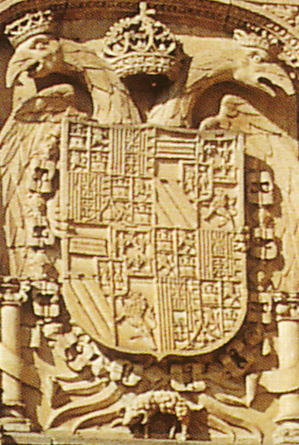
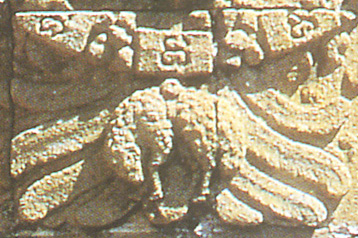
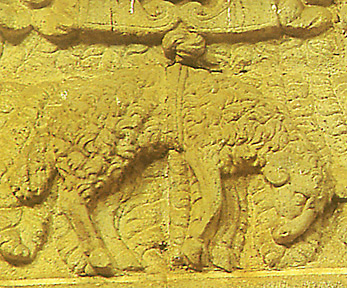
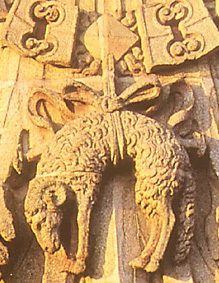
Spain has some other less obvious uses of the standing ram in architectural art as well. Below, at left, is a painted tile coat of arms of Charles V from the Church of Sant Jaume in Alcúdia, Mallorca. Both the nature of 16th century Spanish tile painting and the provincial, off shore island location make for a cartoon-like image, but still one that shows its roots. To the right are the arms of El Cid at Monforte with an added collar of the Golden Fleece that dates to three centuries after El Cid, probably an attempt to show the royal and civic nature of the building.
Under Charles V the Habsburg empire included not only Spain and the ancestral lands in Central Europe, but also Sicily, most of Italy and the New World. It is not surprising that we find the standing ram in architectural ornaments in these places too. Below are two uses of the fleece in Syracuse in Sicily, and one in Mexico from 1528 in the first decade of Spanish control. From the left: Syracuse the Fontana Schaivi., Syracuse Church of Santa Lucia alla Badia, and the Capilla Real de los Indios in Tlaxcala, Mexico. The Tlaxcala carving is most interesting due to its very early date, certainly before any Golden Fleece was ever seen in Mexico and likely from a document seal or portrait. It shows grotesque distortion to fit the space and work by someone who did not understand the image, as we might expect in new colonies populated only by near illiterate conquistadors. Tlaxcala was the first place in Mexico to welcome and support the Spanish, and so despite its isolated mountain location it was an early center of Spanish settlement and construction. Right next to this photo is one of the standing ram fleece on the main facade of the Puebla Cathedral, begun in 1575 under Philip II and finished in 1640 under Philip IV. These arms are a much better and more professional carving, and in marble and not local tufa. The coat of arms this belongs to was likely carved in Spain and shipped to Mexico, and although it may have lain in storage for a while, the facade would be one of the first parts constructed. What this does say is that such a style of fleece was commonly used for some time in Spanish America, and a diligent search could likely find other examples.
 By
the early 16th century printing had become so established and technically proficient
that illustrated books and broadsides of current and ancient events were increasingly
commonplace in the life of the people. Charles V, his family and the great men
of the Golden Fleece are frequently depicted, and we also find wearing of a
standing ram style fleece in these illustrations. At the far left is a 1547
example by M. Heemskereck, who for decades produced engravings of the life and
triumphs of Charles V, Over that long period the fleeces shown were always standing
ram, of one shape or another. This one is of Charles V and a subject king, who
is also a member of the order, wearing very plump standing ram fleeces on ribbons
or chains at the acclamation of Charles V by the church and rulers of Europe.
In 1543 Heemskereck’s “Pardoning of the Duke of Cleves” print
depicts similar shaped but much smaller fleeces. We should note that the most
ancient surviving standing ram fleece, that is in the Bayarische National Museum
(and seen on our Aldenhaag Fleece page), is 9 cm. wide and is in between the
size of the two fleeces shown here.
By
the early 16th century printing had become so established and technically proficient
that illustrated books and broadsides of current and ancient events were increasingly
commonplace in the life of the people. Charles V, his family and the great men
of the Golden Fleece are frequently depicted, and we also find wearing of a
standing ram style fleece in these illustrations. At the far left is a 1547
example by M. Heemskereck, who for decades produced engravings of the life and
triumphs of Charles V, Over that long period the fleeces shown were always standing
ram, of one shape or another. This one is of Charles V and a subject king, who
is also a member of the order, wearing very plump standing ram fleeces on ribbons
or chains at the acclamation of Charles V by the church and rulers of Europe.
In 1543 Heemskereck’s “Pardoning of the Duke of Cleves” print
depicts similar shaped but much smaller fleeces. We should note that the most
ancient surviving standing ram fleece, that is in the Bayarische National Museum
(and seen on our Aldenhaag Fleece page), is 9 cm. wide and is in between the
size of the two fleeces shown here.
For an earlier period we see what appear to be standing ram fleeces in the c. 1528 painting of the entry of Charles V and the Pope into Bologna that is in the Museo Santa Cruz in Toledo, and also in the engraved book on the same subject at Grabando, Florence. [See Goitia et al, pp. 220-223.]
Below is part of another idealized and early colored portrait of the Emperor Maximillian and his family where all males are wearing standing ram fleeces. Only Maximillian and Philip the Fair are shown here as the others are too small to reproduce well at small size. From where ever the artists obtained their models for the fleece, these early 16th century engravers were consistent in their depiction of the standing ram fleece on Habsburg family members of this period.
As time passed this style of fleece slowly modified to suit the new fashions of the baroque, although the standing ram form persisted for a while in Spain, the Low Countries and Austria. First the wool becomes more wooly and lush, the legs widen to be like two fleece covered tear drops and the body thins again to the fleece from a dead animal instead of the whole animal in the flesh. It is, of course, hard to tell if any contemporary depiction is of a currently made fleece or of an old antique reflecting an earlier age. Being the monarch of Spain and head of the order, Philip II had a plethora of fleeces to wear, some new and many family heirlooms. Below we see both a suit of armor especially made for Philip II, a standing ram fleece in a portrait of him by Tiziano and a standing ram worn by Philip on a bronze bust in the Castle Sforza in Milan. In general, most of the fleeces seen on Philip II are standing ram or a recent derivative from it. I have seen at least a dozen contemporary portraits showing Philip II wearing this style fleece. Pictures of some other Philip II fleece examples can be seen on our Golden Fleece Armor page.
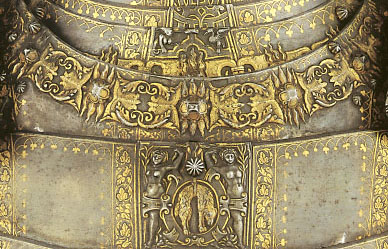
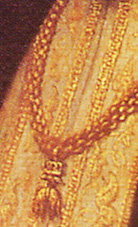
On the death of Philip II in 1598 the government of the Spanish Low Countries passed to Archduke Albert of Austria and his wife Isabella Clara Eugenia of Spain. In the 1623 volume of the history of Brabant by Haraei there is a full page engraved portrait of the two, and both on his person and his arms we see Albert still wearing a standing ram fleece (below left and center).To their right his standing ram fleece is seen in his portrait. And last, in a famous bronze bust of Emperor Rudolf that is in the Schatzkammer in Vienna we see him wearing a standing ram fleece on a ribbon, just as did Charles V. Rudolf was a noted collector and antiquarian and the fleece is likely an old family heirloom (below far right). The mounting ring is close in style to the Aldenhaag fleece and shows how this type fleece was worn on a ribbon. The engraved portrait of Rudolf II by Aegidius Sadeler in 1603 also clearly shows a standing ram fleece.
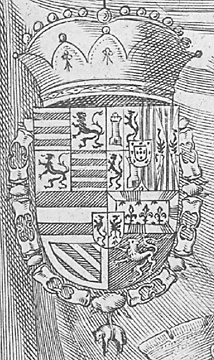
Elsewhere in Europe the standing ram fleece pops up in contexts that seem contemporary and stretch the usage down to the end of the 17th century. On the left is an engraving of Duke Anibale Gonzaga (member 447) in Italy from 1657, in the middle is a standing ram fleece from an oil portrait of a Spanish royal from the last quarter of the 17th century (in a private collection in NY) and on the right a standing ram worn by Ottavio Farnese (member 198) on a marble bust in the Castle Sforza in Milan from between 1546 and 1586. Below these three is an architectural coat of arms of Sigismund III, King of Poland (member 298), from after his 1600 appointment to the order with a clear standing ram fleece. This is the most eastern use of the standing ram known, and one of the latest, although we should expect style and change to move slowly in late Renaissance Europe. The Renaissance began in the 13th century in Italy and only reached Sweden in the 18th. A standing ram fleece is also seen on the 16th century coinage of the Polish monarchs, being on the silver orts of Sigismund II and John II Casimir which can be seen on the Documentation Page, as well as those of Henri II, Duke of Brunswick-Lunebourg in the mid 16th century.
Portraits in the Insignie Orden book show the slow changes in fleece style during the 17th century, with some elements of the standing ram form being retained (most notably full shaped bodies and straight legs) and others changed. By 1700 the transformation was essentially complete. A list of the member numbers in the Insigne Orden showing steps in this development of the shape of the golden fleece will be found through our Catalog Reference Page. We do need to take into account that painters often copied other, older painters for such details as golden fleece collars and rams, so we can not take any one portrait as conclusive evidence for the fleece style of that member’s era, and many members could be wearing family heirlooms. The entire collection of portraits, however, can and does show definite changes within this time frame that completely change the fleece.
Finally, we have a puzzle from a modern find. It is clearly a standing ram fleece
but in lead gilt, a combination otherwise unknown, that was recently found in
Germany and sold on eBay Germany in 2008. It seems to come from a 30 Year War
environment and could have been lost in that era of chaos. Perhaps it was made
so cheaply from poverty, although lead is little less costly than bronze, or
maybe was made to be buried at the funeral of a member of the order. We do remember
the tinsel orders used in the last years of Habsburg Austria for wear on the
uniforms of buried nobility, where they saw no purpose in burying gold and jewels
in the ground too. It shows extensive signs of use and wear which support the
estimate of its age, as does its close resemblance to the Aldenhaag fleece in
form and size. We should also note the second mounting ring, there so it can
be worn on a ribbon as mandated by Charles V.
Beyond the obvious observation on the northern origins of the standing ram in the late 15th century, there are some indications from the use of the golden fleece elsewhere than with the Order that suggest a more specific ancestry for the style. Wool is the cloth of choice and necessity in northern Europe. Anciently, and at least from the Crusades, the wool cloth merchants had a sign of a golden fleece. Not the hanging skin of Greek legend and the Order but a fine, fat ram hanging by a belt from a hoist. Later the fancier merchants would use twisted ribbons rather than a hoist around the ram. The symbol was also used in the arms and artifacts of the wool guilds.
Not
much has survived today from the Renaissance, but in England the usage is well
documented and widespread, especially in the Midlands. Although most documented
uses there are later than the foundation of the order, the fleece was used because
it was anciently connected to the wool trade. Several English users of the golden
fleece in their arms, including the city of Leeds in 1626, specifically state
it was chosen because of the importance of the wool trade. Some of the British
uses are: City of Leeds, Bury, County Borough of Rochdale, Baildon Urban District
Council, Milnrow (crest seen at left), Powis County Council and the Draper’s
Company of London. English families that use this wool trade standing ram in
their arms are: Currey, Currie, Deschamps, Fowkes, Narboon, Narboone and Prowse.
Deschamps even specifies that the ram is girt round with a collar, and Narbonne
that the ram is banded. Across the English Midlands there are numerous pubs,
restaurants and inns called "The Golden Fleece", with signs using
the standing ram. These likely go back at least to the time of Edward IV whose
sister married Charles the Bold and to whose court he fled for a year when Warwick
temporarily defeated him. Edward IV, Henry VII and Henry VIII were all members
of the Golden Fleece. At the right is a standing ram fleece worn by Henry
VII in a portrait after 1490.
Pubs and inns in Britain using the Golden Fleece, not to mention woolen draper signs, include the towns of: Blackley, Calderbridge, Carlisle, Chelsford, Chester, Leeds, London (Queen Street and Manor Park), Nottingham, Oldham, Portmadog, Saddleworth, St. Cuthbert, Stamford, Studley, Tremadog and numerous others. The same is true for Australia, New Zealand, and some are also in Canada and the U.S. Below are several English pub signs using the standing ram Golden Fleece of the woolen trade. From the left York (from before 1503), Stamford, unknown location.
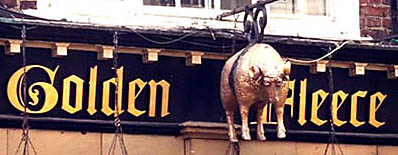
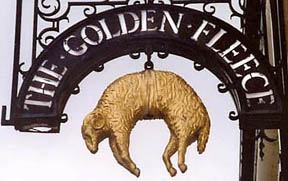
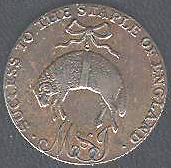 Interestingly,
this fleece is also found on the trade tokens that circulated for centuries
in England when formal currency was scarce, and later on Australian coins. Ted
Loker, in his "Ted’s Tokens" web site, documents many of these
tokens and also independently notices the different form of the standing ram
fleece used there. In his text he says: "unlike the order of the Golden
Fleece, this fleece appears to be the entire (live) animal, and not just the
skin." At the right is a token from Dunkirk in Somerset from Ted’s
pages showing the use of the traditional wool trade fleece.
Interestingly,
this fleece is also found on the trade tokens that circulated for centuries
in England when formal currency was scarce, and later on Australian coins. Ted
Loker, in his "Ted’s Tokens" web site, documents many of these
tokens and also independently notices the different form of the standing ram
fleece used there. In his text he says: "unlike the order of the Golden
Fleece, this fleece appears to be the entire (live) animal, and not just the
skin." At the right is a token from Dunkirk in Somerset from Ted’s
pages showing the use of the traditional wool trade fleece.
The Golden Fleece is even more popular in Australia and New Zealand where it is in the New Zealand Arms, those of New South Wales, Melbourne and Adelaide, not to mention ships, trains, race horses and gasoline companies. In America Brooks Brothers chose just this wool trade fat fleece for their symbol in the 1880s and use it today on all their clothing. All these derive from and depict the full ram of the ancient wool trade signs. Were we to make a careful examination of the signage and guild symbols in the northeast of France, Belgium and the Netherlands we would likely find the same style there from the same antiquity. The wool trade between England and the Low Countries was long standing and a major business for all. The real social and economic world of the northern wool trade and guilds spanned the English Channel and the North Sea with the waters being a uniting force that gave inexpensive transport. In the 14th century the English supported and were closely allied with the burger rebels against the French nobility. With their defeat and the Burgundian ascendancy after 1364 the English continued the connection and transferred their alliance to the Burgundians. We should therefore expect similar trade symbols in such a tight knit region.
When Philip the Fair lived there, and later when the young Charles V was growing up in the Low Countries, there was a new court that needed all the trappings of grandeur and power, including the Golden Fleece. As local jewelers turned to making the ram it is most likely they turned to the long established version used by the wool trade and a symbol they likely saw most every day in their own towns. This symbol was not in general use on trade signs for wool in the south or east of Europe but only here. It has to be more than chance that the standing ram fleece suddenly appears here (despite some precursors) when a Hapsburg court is established and then vanishes when all the court and its lifestyle moves to Spain with Philip II in the late 16th century.
This also has wider implications about the origin of the Order of the Golden Fleece itself. There has been much conjecture and study about why Philip the Good chose the Golden Fleece as an order. Perhaps, with his happiness at the great wealth from the Low Countries, he noticed the wool sign as he traveled though his cities there and it inspired his vision. If so, we owe a lot to this well fed ram of the wool trade.
And
just so we do not doubt the antiquity of the standing ram form, at the left
is a photograph of such a ram used as a first century A.D. Roman bronze mount
that was found in Britain, complete with hoisting strap! Only 29 mm wide and
missing half its front legs, it seems to be a prototype for many standing ram
fleeces of the Renaissance. As it came from a dealer in Tamworth, in the West
Midlands of England, we can call it the Tamworth Fleece. As with so much
else, we see that our organization and symbolism often come from the minds of
the Romans. Look into that last, great compendium of all Roman government, the
Notitia Dignitatum of 408 A.D., and you see all the Medieval and Modern
clerical districts, the borders of modern states and lists of the officials
to run them that even today are similar.
From this ram mount it seems that the Golden Fleece was not only a popular Roman theme, but that its wool guild connections could well date back to their Roman origins, and have survived in some form until the guild revival across Europe in the 11th and 12th centuries. Since these Roman bronzes were most often at least semi-mass produced by casting, the wool guilds could also have seen a Roman item like this and taken it to their own use, although it is seems less likely without a lot of presuming how Medieval minds worked. We blame the barbarian invaders for the feudal system, but it was a Roman creation to help tax collection, and we see craft guilds as a Medieval style, but they too are a Roman creation to help control work and pay. I see little reason that the symbols of the trade should not have also been retained just as the institutions themselves were. And so we have traveled from Mycenaean Greek adventures in mysterious lands, to Roman popular imagination to Renaissance badges of honor and service to the great rulers.
It is of great interest that at the top of the lifting strap here is a square little box shape, exactly as found on the front of the Aldenhaag Fleece 1300 years later. I had wondered at its purpose on the Aldenhaag Fleece where it is so large and cube-like, and here see it is clearly the knot or cinch that tightens the strap.The Renaissance copier of the Roman design failed to understand the feature and so made it into a mere decorative blob. Of equal interest is that this Roman mount is copied from a hanging amulet, it seems, as there is clearly visible a circular indentation through the topmost loop like a hole for hanging the fleece, something a mount has no need of. The wool is engraved in minute detail and the horns are cross cut with lines just as in the later Golden Fleeces. Were this Roman bronze 50 mm wide, doubled sided and in gold it would look like the near-twin of the Aldenhaag Fleece. The correspondence of so many minute details likely confirms that the Romans used such an image, that it was passed on through the Dark and Middle Ages to the Renaissance guilds, and finally to the Order of the Golden Fleece for a brief century in the Low Countries.
It should be noted that despite being widely popular at different times the Golden Fleece had peaks and troughs of popularity. Known in ancient epic poetry it seems to fade with the Mycenaean kings, only to rise again as a new Hellenistic epic poem by Apollodorus of Rhodes in the third century B.C. As Greek culture is submerged by the Roman conquest of the Mediterranean it then reappears in a purely Roman context, and in Latin, with an epic poem by Gaius Valerius Flaccus in the time of Domitian around 80 A.D. Perhaps this revival reflects Roman interest in wealth and adventure in their young empire, It is noteworthy that this period is that of the supposed date of this bronze fleece and so supplies a likely reason why such an unusual subject is found in Britain in the late first or early second centuries.
Although I have not found the Golden Fleece on any ancient coins there are many representations of ships and their bows that could be the Argo, and the fleece is seen on a few pottery paintings. Of course this is mainly a story about Iolcus and the southeast Thessalian Mycenaeans, from whom Nestor of Pylos also descends. Archaeology of Thessaly is behind most of Greece and so we have little material to examine, although the great palace at Iolcus has been located and partly excavated. Just as with the Calydonian Boar of Kalydon in Aeolus, the full poem of the Voyage of the Argo was likely lost with its noble patrons c. 1200-1100 B.C. It did, of course, hold on to the Greek imagination, and as seen in various versions almost every great hero of early Mycenaean Greece was placed among the crew of the Argo — so many that a modern cruise ship would almost be required to carry them all. We see the same demand for inclusion in the catalog of ships in the Iliad where far too many warriors are sent to Troy. We do notice that elements of these stories function as symbolic imagery, as some warriors from Kalydon are said to have had boars on their shields, and those from Mycenae lions, the heraldic beast of the town and its ruling family. Those from Iolcus thus likely had golden fleeces on their shields and Boetians a sphinx. By the time we get to the shield of Achilles at Troy there is a whole volume of mythology in the many images on his shield. These were not merely brave stories of great men but also origin myths for warrior aristocracies. For more on this, and photos of surviving ancient depictions of the fleece, use the link below:
II. The Hamlets of Thedinghsweert & Zoelen-Aldenhaag
III. The van Egmonds, Claes Vijgh & The Golden Fleece
Appendix 1. The Standing Ram Fleece As Seen in the Insignie Orden Book & Other Catalogs
Appendix 2. Other Scholars Look At the Aldenhaag Fleece
Appendix 3. Greek & Roman Mythology of the Golden Fleece
3B. Classical Texts That Mention the Golden Fleece
May 2010 Meeting on the Aldenhaag Fleece — 1. The Places
May 2010 Meeting on the Aldenhaag Fleece — 2. The Fleece
Return to Society of the Golden Fleece
Return to the Golden Fleece Insignia Page
Antiques AtoZ Home Page
Medals, Orders
& Decorations